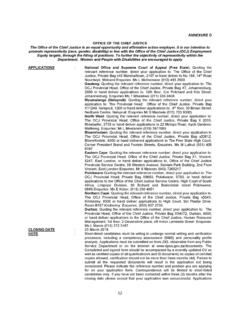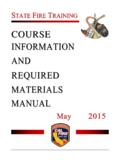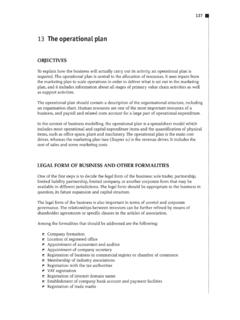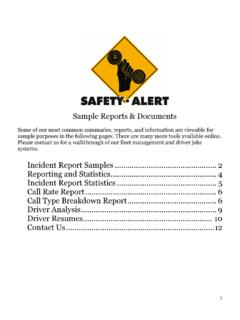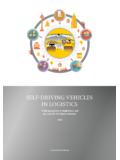Transcription of Driver License Appeal Practice Manual - michigan.gov
1 Driver License Appeal Practice Manual michigan Department of State 2005 michigan DEPARTMENT OF STATE Driver License Appeal Practice Manual TABLE OF CONTENTS I. Background .. 1 II. Responsibilities for Traffic Safety within the 2 III. An Overview of the .08 Legislation .. 6 IV. Driver Responsibility 11 V. The Emergency Responder Act .. 11 VI. Person Under 21 Purchase/Consume/Possess 12 VII. Repeat Offender 12 VIII. Mandatory Licensing 14 IX. Implied-Consent Hearings .. 24 X. Habitual Offender License Appeal Procedures .. 28 XI. Relief Available in Circuit Court .. 32 XII. Restoration Appeal Process .. 36 XIII. Key Restoration Appeal Cases .. 38 XIV. Commercial Driver License (CDL) and Snowmobiles & Watercraft .. 45 XV.
2 Master Driving 50 Frequently Asked Questions: Repeat Offender .. 54 Registration Denial .. 69 Breath Alcohol Ignition Interlock 71 ORV/Snowmobile .. 75 Graduated Driver 76 Appendices: Alcohol and Driving in Appendix A Graduated Driver Licensing Requirements .. Appendix B Driver License Appeal General C Repeat Offender Charts ..Appendix D DI-93 Refusal Form .. Appendix E Substance Abuse Evaluation Appendix F Hearing Officer Relief G Request for Driver H Diagram of Restoration Appeal Process .. Appendix I SCAO Appendix J Request for Action K michigan Court of Appeals Appendix L International Reciprocity Appendix M michigan CDL Guide ..Appendix N How to Read a Driving Appendix O Offenses for Minors Chart ..Appendix P Department of State Reinstatement Fee Chart .. Appendix Q This Manual is intended to assist defense attorneys, prosecutors, judges, and other interested parties involved in the Driver License Appeal process as well as with other licensing actions.
3 These materials contain statutory references, case law summaries, Department rules and forms, statistics, charts, and other information. If you have any questions concerning the materials in this Manual , please feel free to contact the Driver Assessment and Appeal Division, (DAAD), at 1-888-SOS-MICH (888-767-6424). I. Background The michigan Department of State, (the Department), is the government agency that is responsible for promoting traffic safety and regulating driving activity. The michigan Legislature vests the Department with this authority through the michigan Vehicle Code, 1949 PA 300, as amended; MCL et seq. The vast majority of traffic injuries and deaths are caused by a small number of high-risk drivers with multiple offenses on their driving histories. In 2002 there were 1,279 traffic fatalities in the State of michigan , a reduction of from the year before. Reductions in fatalities have been a continuing trend in michigan since the early 1990s.
4 Nationally, fatalities increased by in 2002. According to the University of michigan Transportation Research Institute, [UMTRI], of all alcohol-related crashes in 2002 resulted in injury or death, and of all fatal crashes were alcohol related. Since 1991, the michigan Legislature has demonstrated a commitment to reduce the incidence of drunk driving and to remove other high-risk drivers from our roads. In January 1992, the Legislature enacted a series of bills that increased minimum sanctions for drunk drivers , created two new felony drunk driving crimes, set consistent licensing sanctions, and eliminated hardship appeals for habitual offenders. A follow-up UMTRI study found that the January 1992 changes to the Vehicle Code helped reduce traffic fatalities by as much as 25%. However, the study also demonstrated that an estimated 30-70% of these drivers continued to drive at least some of the time during their licensing sanction.
5 By the year 2000, one Driver had accrued 16 alcohol-related convictions. Another Driver had accrued a series of License revocations through the year 2183. In 1998, the Legislature passed the Repeat Offender Legislation to address these ongoing concerns. Because there continued to be substantial inconsistencies in court sanctions, the Legislature removed certain licensing actions from the courts and consolidated these responsibilities within the Department. Sine October 1, 1999, the Department must impose a defined licensing sanction when an abstract of conviction is received from a court. As in the past, the courts continue to determine responsibility or guilt for a driving offense. However, most licensing sanctions are now imposed by the Department. The Department has no discretion to waive or amend a licensing sanction once an abstract of conviction has been received, nor will the Department backdate mandatory licensing sanctions based on untimely abstracting of a conviction.
6 Another substantial change since October 1999 is the Ignition Interlock program. The Legislature charged the 1 Department with the responsibility of administering the Ignition Interlock program. An interlock device is an added condition to a restricted License that prevents a habitual drunk Driver from driving after consuming alcohol. MCL (6) II. Responsibilities for Traffic Safety within the Department Office of Traffic Safety The Office of Traffic Safety provides the primary traffic safety focus for the Department of State. This focus includes the Department s Traffic Safety Initiatives supported by Secretary of State Terri Lynn Land, and oversight of the Motorcycle Rider & Safety Education Program and Driver Education Program.
7 The Office of Traffic Safety represents Secretary Land on the Governor s Traffic Safety Advisory Commission and various traffic safety committees throughout the state. Speaking engagements are provided by staff in the Office of Traffic Safety, updating the public on the modernization and new initiatives undertaken throughout the Department of State. Traffic safety analysis is also performed and reports are prepared that summarize findings. Bureau of Branch Office Services (BBOS) In April 2004 Secretary of State Terri Lynn Land initiated the Branch Office Optimization Plan, reducing the number of branch offices and creating several Super!Centers and Plus Offices that provide increased services. In addition to extended or expanded service hours, additional services at these branch offices will allow customers to purchase copies of their driving records, apply for instant titles, take mechanic tests, and use a Discover credit card to pay for transactions.
8 Some of these offices may also include the ability to hold Driver Assessment reexaminations or Driver License Appeal hearings. A prospective Driver will initially make application for licensure at a branch office, and with compliance of all of the licensing requirements, the Department will issue a Driver License . However, the Bureau of Branch Office Services (BBOS) representatives may also deny a prospective Driver s License request at a branch office based on a person s medical condition or other statutory reasons found in MCL (1)(d). A written application denial is presented to an applicant and explains the reason(s) for denial. An application denial also includes an explanation of the right to Appeal to License Appeals or to Circuit Court in the county where the Driver lives. Driver Assessment Reexaminations Driver Assessment (DA) analysts hold reexaminations in several locations around the state.
9 MCL and MCL The most common reasons for conducting Section 320 reexaminations are: A Driver accrues 12 or more points on their License within a two-year period. 2 The Department receives notice that a Driver may have a serious medical condition or is otherwise unable to operate a vehicle in a safe manner. Traffic fatalities. Violations of restricted licenses. Incurring three at-fault crashes within a two-year period. After a reexamination, the Department has the authority to restrict, suspend, or revoke a License . The main goal of these actions is not to punish drivers for unsafe driving, but to motivate improvement and to protect other drivers . The Probationary Driver program is based on Section 310d and is premised on the theory that good young drivers make good adult drivers .
10 The minimum period for probationary drivers extends for three years. If a probationary Driver demonstrates unsafe driving behaviors, the Department does not need to wait until a Driver incurs 12 points to take action. A probationary Driver may be reexamined for incurring one traffic violation in their first year of driving. Reasons that allow for a Section 310d reexamination after the first year of probationary driving include: Incurring a 4-point offense. Incurring three traffic offenses. Incurring six or more points in total. The probationary term will be extended beyond three years for moving violations, negligent or alcohol indicated crashes, or License suspensions during the last ten months of probation. At the reexamination, DA analysts may warn or counsel young drivers , or may impose other licensing sanctions such as restrictions or a suspension. The goal of the program is not to punish young drivers , but to motivate improvement and to protect other drivers .










